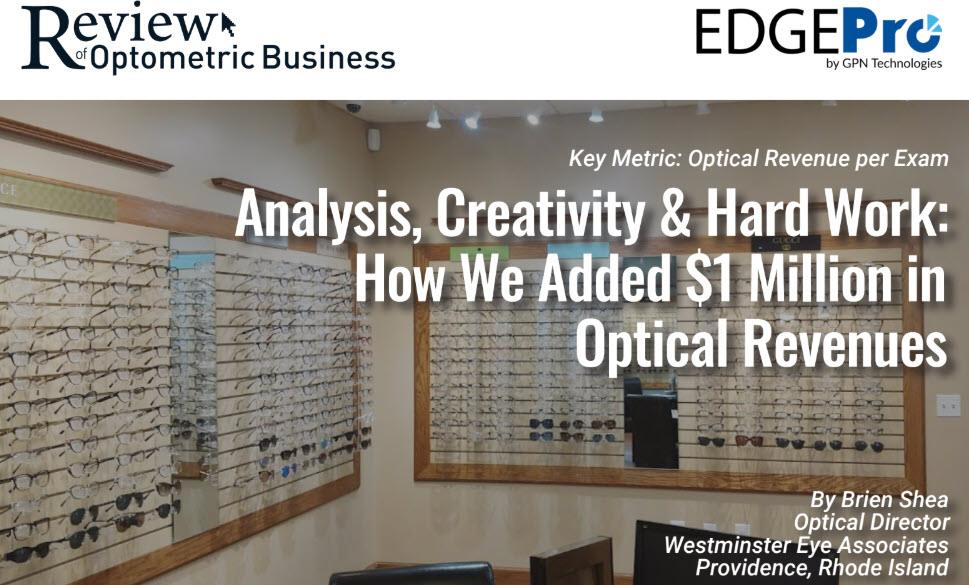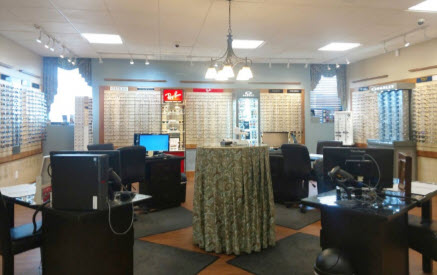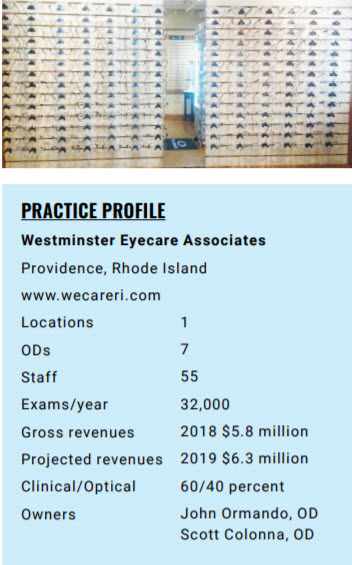Sponsored Content
Oct. 9, 2019

Two years ago, I came to Westminster Eyecare Associates in Providence, R.I., to increase profitability and efficiency. I found a unique set of circumstances and challenges. The patient base encompasses all ages, over 90 percent is Hispanic, and 70-80 percent have a form of insurance, commonly state-funded. Also, the practice was set up for high-volume, with seven ODs and a staff of 55 providing 32,000 exams a year.
When I analyzed the profitability of the practice, one metric stood out: Optical revenue per exam was about $80. That is dramatically lower than the national average of $154, with the top 10 percent of practices reaching $231, according to aggregate data from EDGEPro by GPN Technologies.
In analyzing the financial health of a practice, revenue per exam is perhaps the most oft-cited performance metric that reflects profitability. That figure averages $377, with the top 10 percent reaching $504, says EDGEPro. But tracking and improving optical revenue per exam is equally critical because this sorts out the performance of your optical department from the business performance of ODs and staff on the clinic side. OD-owners who just lump these together, often fail to see where performance gains can be made.
It’s now two years down the road. We have increased overall revenue by $1 million to a projected $6.3 million this year. And we have done it largely by conducting a thorough cost and price analysis and by changing margins in specific areas to achieve gains of $2 and $5. We found plenty of areas where we could do that.
In retrospect, I estimate that $250,000 of that $1 million gain came from just paying attention to performance numbers, which is where a lot of OD-owners tend to look away or delegate. The remaining $750,000 gain came from a multifaceted process of close analysis, experimentation with pricing, bundling and presentation and then adjusting our changes to succeed. In other words, it’s taken a lot of hard work, but it’s paid off big time.
Conduct a Cost Analysis
The first step in analyzing the performance of this practice is to begin an essential process that all practices should do: Go to the basement with a calculator, pencil and paper–and stay there for about 16 hours until you understand where your profits are made or lost.
You need to examine all costs of goods, pricing strategies and profitability. You do that by looking at every exam fee, sale price and margin over a period of three consecutive days.
“What did we pay for this set of lenses?” I asked our optical manager. “Then, how did we price them?”
That led to solutions.
Be Creative in Pricing for Revenue Gain
In some cases, the solution was to raise a lens price by $2, but in other cases we lowered the price. Simply raising prices is not a magic bullet.
One approach we applied is the “popcorn strategy” developed at movie theaters: A small popcorn is $4.50 but a large on is only $5. Movie-goers go for the large since it’s only 50 cents more. They see the value–and, importantly, they feel in charge of their purchase decision.
Apply that to AR and polycarbonate frames. Our polycarboanate lenses were priced at $79. We raised the price to $179. However, our AR coating was $150, and here we were capturing just 7 percent. So we provided a package: For $209 you could have a polycarbonate lens with AR coating–a value. We presented the $209 option prominently.
“Well, can I get just the polycarbonate lens alone?” patients asked.
“Sure, that’s $179,” our staff replied.
“Oh, well, for just $30 more I can have both?” patients replied. “OK, let’s do that.”
As with the popcorn sale, patients saw the value and felt in charge.
We also applied the “empty soda bottle” strategy. One day, I sat with the two OD-owners of the practice, I offered to pay $10 for the empty soda bottle sitting in front of them. “I’ll take it!’ they both said.
The next day, same set-up, I offered $5. One owner declined since he had just gotten twice that. He missed an opportunity to profit. The other said yes. A profit could be made, even if it was half the profit of the previous day.
We make that mistake every day. Another mistake is assuming that if one person will see a value, everyone else will, too. That mentality is a recipe for losing sales.
 Spot Improvement Areas, Apply Growth Strategies:
Spot Improvement Areas, Apply Growth Strategies:
Pediatric Frames
In our state, reimbursement for pediatric frames is $12. We can provide families with a pediatric frame that costs us $3-5 wholesale, but we often offer a better quality frame even though our COG is $18-25. We lose money, but we better serve a pediatric patient and cultivate the parents and siblings of that patient. If the $3-5 frame breaks, we could lose the entire family as customers. Far more valuable is the exam revenue. If we work in isolation, we don’t see that.
AR Capture Rate
Two years ago, our AR capture rate was 12 percent, and that came primarily from our VSP patients, who have a benefit for it. Virtually no one else elected this premium. We needed to fix that and did: Our AR capture rate now is 70 percent. Our strategy involved a combination of lens sourcing, bundling and presentation. First, we sourced a less expensive premium AR treatment lens. This, in turn, allowed us to price AR so it was affordable and attractive to patients who paid very little or nothing for their eyeglasses.
They never were going to pay $150 for AR, so we were not losing them. However, you need to be cautious not to play against your self-pay patients. Make sure that for every level of paying customer, you offer their own branded product. Create a package that serves each person’s needs. AR is a great place to start improvements in profitability. Just improving AR captures by 5 percent can make an enormous difference to your bottom line.
Polycarbonate Lenses
We called in our lens reps and showed them our profit goals. Then we asked them to help us get there. Opportunities came up where we could buy lens blanks for less. Again, saving $2 on a set of lenses adds up at high volume. One important point: You need to do your own edging. You can’t farm that out or your costs escalate and you have to charge so much you lose sales–and patients altogether. We have an outstanding veteran lab staff that turns around lens jobs quickly and with the highest quality.
 Independents Can Compete
Independents Can Compete
Independent OD-owners can compete with online retailers and low-cost brick-and-mortar competitors. But you need to work hard at it, not just raise prices and call yourself a luxury optical shop. You have to get into the nooks and crannies.
Engage Staff with Optical Revenue Per Exam
In the case of a high-insurance plan, high-volume practice like ours, tracking optical revenue per exam is critical. However, we don’t track this metric to compare it to national norms. Rather, we use it to track and analyze inter-staff performance overall practice goals.
 I managed a Lenscrafters where optical revenue per exam was $380 versus our $80, but that was an entirely different setting and patient base. We’re not going to get to $380 and we don’t need to.
I managed a Lenscrafters where optical revenue per exam was $380 versus our $80, but that was an entirely different setting and patient base. We’re not going to get to $380 and we don’t need to.
But we can improve profits.
The key is to engage and empower your staff to examine this metric, looking at how they perform compared with their colleagues in their department. In our case, there are three: lab, gallery and dispensing. We provide our team access to EDGEPro so that our staff can see their individual performance.
In staff meetings, we strategize how to make improvements based on numbers and not emotions or individual instances where one person feels they are carrying a heavier load. It’s all there in the numbers, and we discuss performance on an objective basis.
By doing this, EDGEPro can provide a vital insight: If a metric is lagging behind, is that a product of poor presentation? Or is it mis-priced? Further, is there a disconnect between what the doctor may be saying and the optical staff is missing?
You can sort out practical problems from systemic or cultural problems. Then you can begin to address challenge areas, set improvement goals and track progress as you get to where you want to go.























